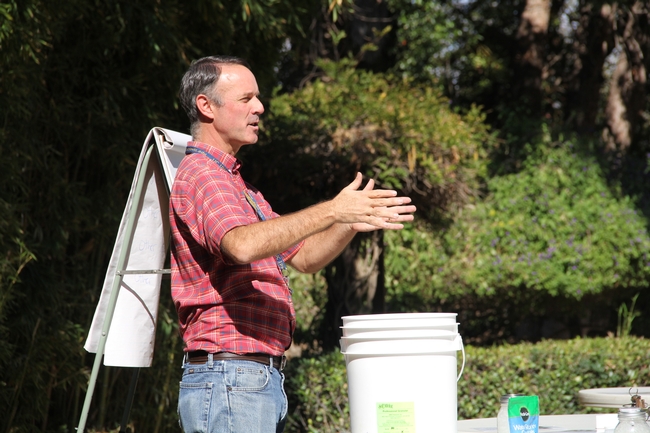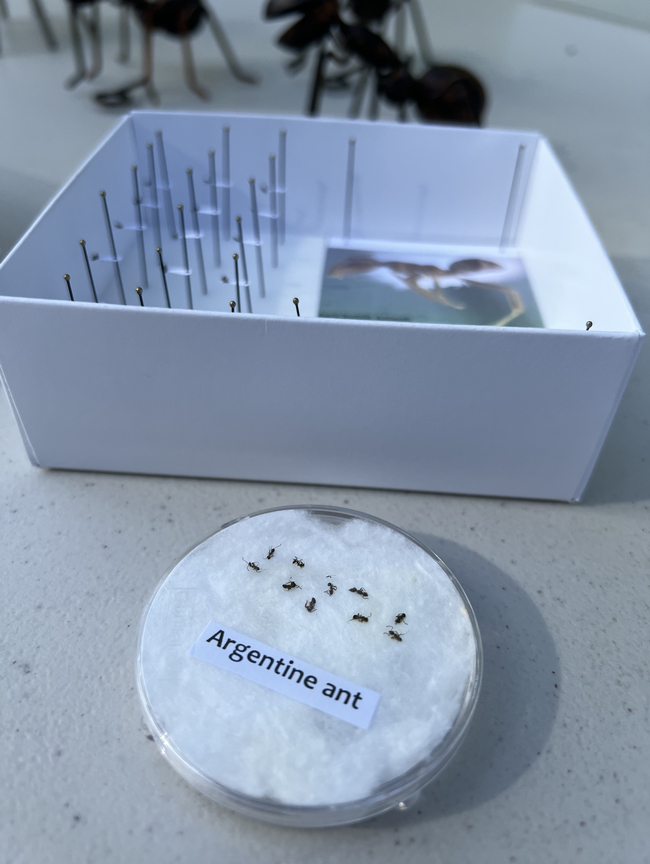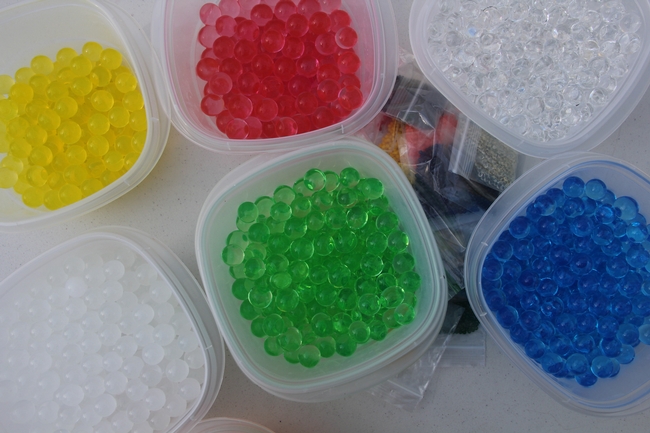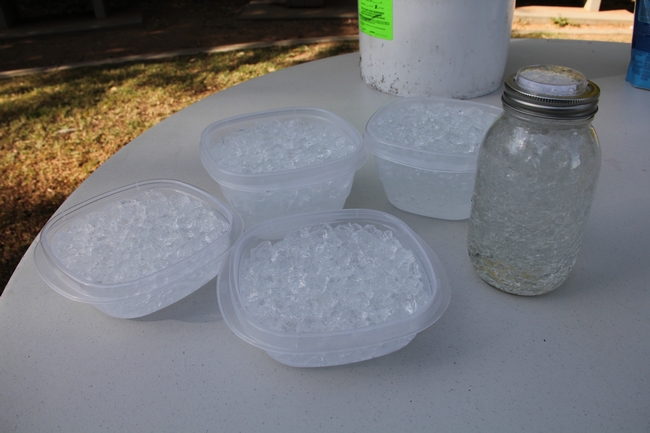Posts Tagged: ants
The Morphos! The Monarchs! The Bohart!
When the Bohart Museum of Entomology hosts an open house, a sure crowd-pleaser is the global Lepidoptera collection, which totals some...
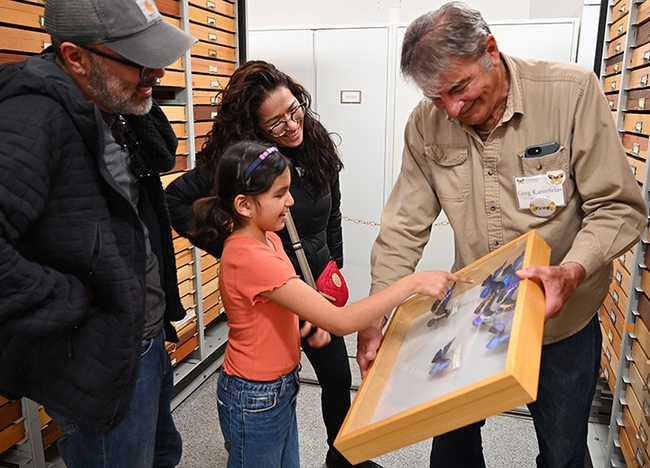
Martha Leija and Mario Preciado and their daughter Valentina, 8, a family from Mexico City, check over the morpho butterflies. At right is Bohart associate Greg Kareofelas. (Photo by Kathy Keatley Garvey)
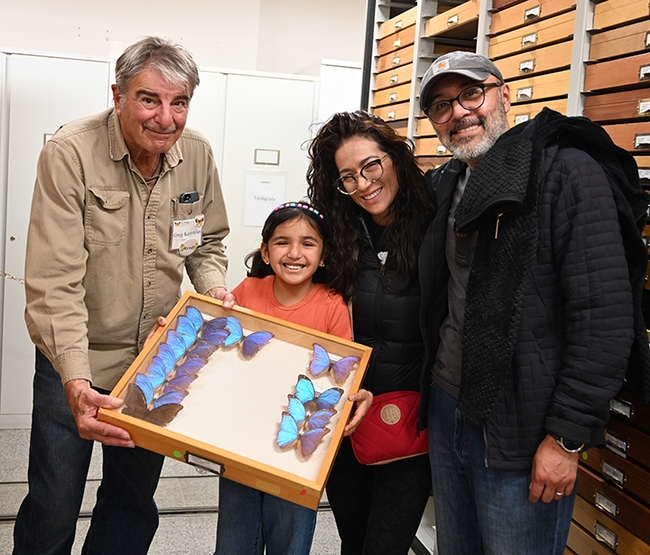
Bohart associate Greg Kareofelas (left) poses for a photo with a visiting family from Mexico City: Martha Leija and Mario Preciado and their daughter Valentina, 8. (Photo by Kathy Keatley Garvey)
Got an Ant Question? Ask Away at UC Davis Biodiversity Museum Day
Got a question about ants? Or other insects? By popular demand, ant specialists (myrmecologists) from the Phil Ward lab, UC Davis Department of...
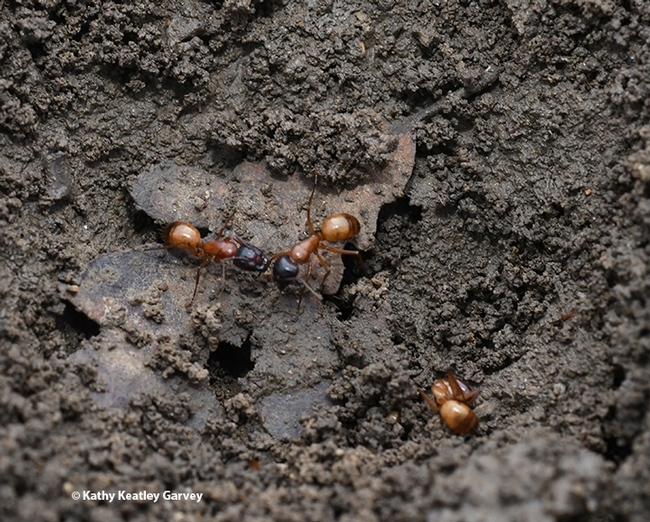
How much do you know about ants? Members of the Phil Ward lab will discuss ants and answer questions at the UC Davis Biodiversity Museum Day. Here carpenter ants (Camponotus semitestaceus) nest in a Vacaville park. (Photo by Kathy Keatley Garvey)
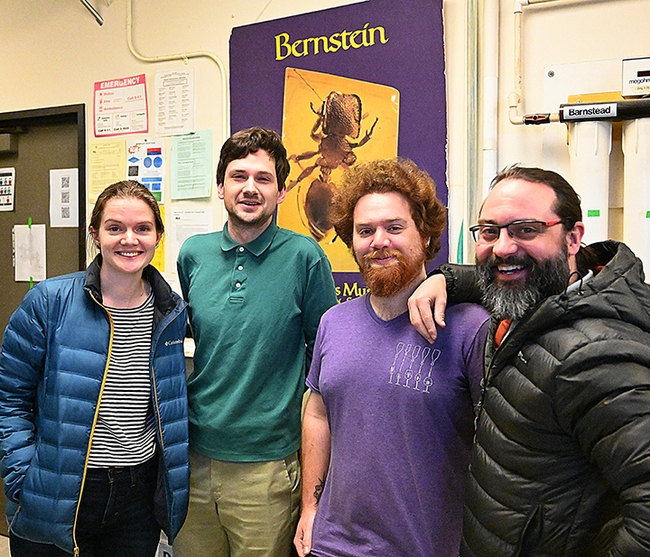
Meet The Ant People (Myrmecologists) from the Phil Ward lab at UC Davis. From left are doctoral candidates Jill Oberski and Zach Griebenow; graduate student Ziv Lieberman; and alumnus Brendon Boudinot. (Photo by Kathy Keatley Garvey)
UCCE researchers target sugar-feeding ants, a key to controlling citrus pests, disease
Sugar-feeding ants protect pests that infect trees and damage the fruit they bear. Insecticides are often a go-to solution, but may kill beneficial insects in the process, too. Thankfully, Mark Hoddle, University of California Cooperative Extension entomologist and biological control specialist at UC Riverside, together with UCR colleagues in chemical engineering, developed a biodegradable hydrogel baiting system that targets ant populations, which protect sap-sucking pests from their natural enemies. Control of ants allows beneficial parasitoids and predators to greatly reduce pest populations.
Deciding to expand Hoddle's research was a “no-brainer” according to David Haviland, UC Cooperative Extension farm advisor in Kern County.
Haviland is investigating active ingredients that can be effectively used in hydrogel baiting systems. His research builds on Hoddle's use of alginate gels, also known as water beads, soaked in sugar water to control Argentine ants.
“What we're doing in California can benefit places like Florida, Texas, Mexico and beyond,” Haviland said.
The Hoddle lab conducted two years of orchard research showing that when ants are controlled, the amount of citrus flush infested with Asian citrus psyllid (ACP), a mottled brown insect that vectors the pathogen causing citrus greening, decreases by 75%. Citrus flush refers to newly developed leaves.
“But benefits are not restricted to just ACP with Argentine ant control, as natural enemies destroy colonies of other sap-sucking pests too,” said Hoddle. “For example, citrus mealybug infestations on leaves were completely eliminated by natural enemies, 100% control, while densities of fruit infested by mealybugs were reduced by 50%.”
The Hoddle lab's success inspired Haviland to consider how this approach will fare in different regions of the state where there are different crops, different pests and different ant species.
Haviland has worked for many years on solid baits that are effective and affordable for ants that feed primarily on protein, like fire ants in almonds, but successful control measures for sugar-feeding ants that drink their food have been elusive.
“Therefore, we're using hydrogels to essentially turn a liquid bait into a solid, making it effective and commercially adoptable,” Haviland said. He and his team are assessing whether active ingredients that undoubtedly work against ants, like thiamethoxam, maintain their effects in a hydrogel system.
Unlike Hoddle's biodegradable alginate gels, Haviland is relying on acrylamide gels that are similar to the absorbing material you would find in a diaper. These gels are not organic, but are currently accessible on a commercial scale, and have been shown to be effective in wine grapes on the North Coast by a Cooperative Extension advisor in Napa County, Monica Cooper. Haviland's current research efforts are focused on citrus, table grapes and wine grapes in the San Joaquin Valley, and on lemons on the coast.
The primary challenge now is navigating pesticide regulations and registration.
“This is cutting-edge research,” Haviland said, and manufacturer labels for the products being used need to be updated to include hydrogels as an approved use. This process takes time. Additionally, adding new product uses needs to make economic sense for the manufacturer.
Hoddle and Haviland's research can provide data for adding these methods to the product labels.
“If we can show that this tech works against lots of pests, lots of ant species, in lots of different crops across California, hopefully we'll achieve a critical mass of benefits that motivates product manufacturers to make modifications to their labels,” said Haviland.
Haviland is hopeful about the process, and said he believes that UC ANR is in a prime position to lead innovation for an issue that requires collaboration among specialists, advisors and the industry.
When Being Framed Is a Great Thing!
Usually when you say "I was framed," it's because someone has accused you of something you didn't do. With the Entomological Society of America...
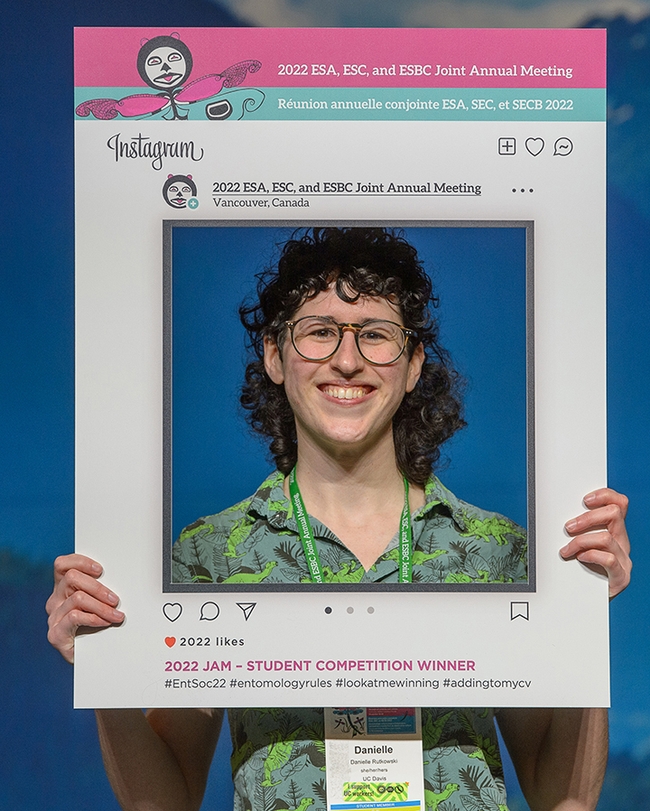
UC Davis entomology doctoral candidate Danielle Rutkowski won an Entomological Society of America President's Prize for the second consecutive year. (Photo courtesy of ESA)
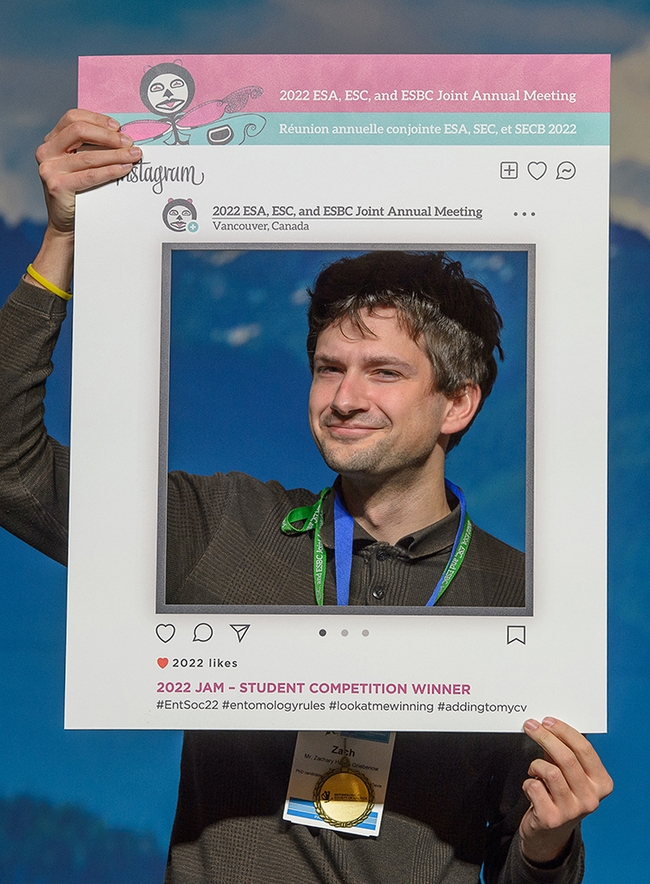
UC Davis doctoral candidate Zachary Griebenow won a President's Prize at the 2022 Entomological Society of America meeting. (Photo Courtesy of ESA)
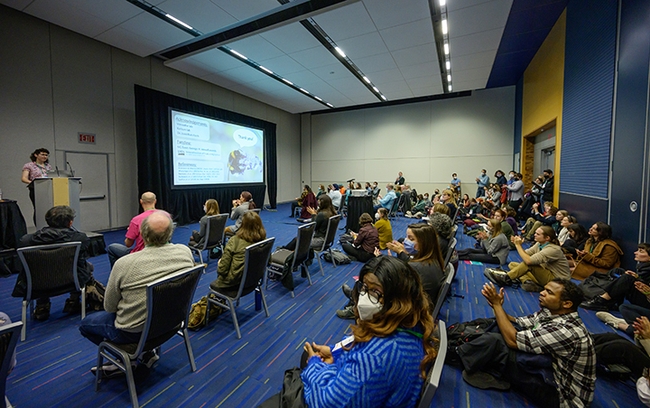
A large crowd listened to UC Davis doctoral candidate discuss her research, “The Mechanism Behind Beneficial Effects of Bee-Associated Fungi on Bumble Bee Health." (Photo courtesy of ESA)
UC Davis Alumnus Marek Borowiec: Remembering E. O. Wilson
The work of legendary E. O. Wilson (June 10, 1929 – Dec. 26, 2021) influenced so many students to begin the scientific study of ants...
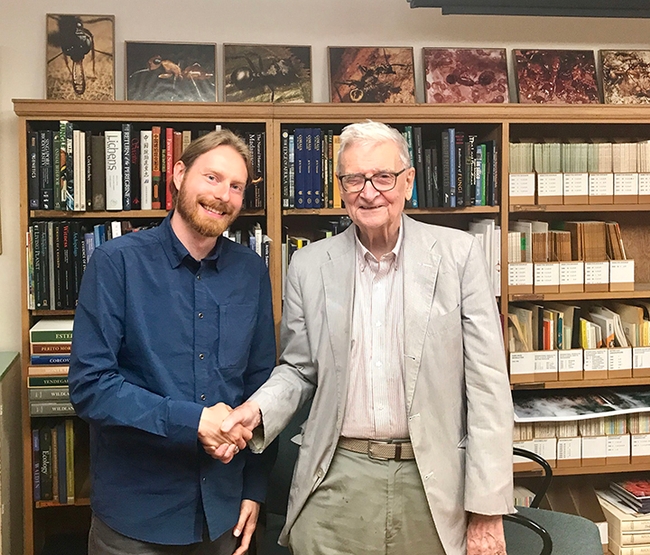
Marek Borowiec (left) shakes hands with E. O. Wilson at the Harvard Museum of Comparative Zoology (MCZ). Borowiec went on to receive his doctorate in entomology from UC Davis and is now an assistant professor at the University of Idaho.


